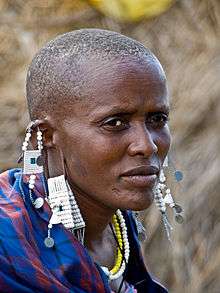Maasai language
| Maasai | |
|---|---|
| ɔl Maa | |
| Native to | Kenya, Tanzania |
| Region | Southern Kenya and Northern Tanzania |
| Ethnicity | Maasai people |
Native speakers | 1.3 million (2006–2009)[1] |
|
Nilo-Saharan?
| |
| Dialects |
Purko
Kaputiei
Keekonyokie
Laitokitok
Iloodokilani
Damat
Loitai
Siria
Moitanik (Wuasinkishu)
Kore
Arusha
Kisonko
|
| Language codes | |
| ISO 639-2 |
mas |
| ISO 639-3 |
mas |
| Glottolog |
masa1300[2] |

Maasai or Masai (English pronunciation: /ˈmɑːsaɪ/;[3] autonym: ɔl Maa) is an Eastern Nilotic language spoken in Southern Kenya and Northern Tanzania by the Maasai people, numbering about 800,000. It is closely related to the other Maa varieties: Samburu (or Sampur), the language of the Samburu people of central Kenya, Chamus, spoken south and southeast of Lake Baringo (sometimes regarded as a dialect of Samburu); and Parakuyu of Tanzania. The Maasai, Samburu, il-Chamus and Parakuyu peoples are historically related and all refer to their language as ɔl Maa.
Phonology
The Maasai variety of ɔl Maa as spoken in southern Kenya and Tanzania has 30 contrasting sounds, which can be represented and alphabetized as followsː a, b, ch (a variant of sh), d, e, ɛ, g, h, i, ɨ, j, k, l, m, n, ny, ŋ, o, ɔ, p, r, rr, s, sh (with variant ch), t, u, ʉ, w, wu (or ww), y, yi (or yy), and the glottal stop ' (or ʔ).
Tone is extremely important for conveying correct meaning in the Maasai language.
Consonants
In the table of consonant phonemes below, phonemes are represented with IPA symbols. When IPA conventions differ from symbols normally used in practical writing, the latter are given in angle brackets.
For some Maasai speakers, the voiced stop consonants are not particularly implosive (e.g. IlKeekonyokie Maa), but for others they are lightly implosive or have a glottalic feature (e.g. Parakuyo Maa). In Arusha Maa, /p/ is typically realized as a voiceless fricative [ɸ], but in some words it can be a voiced trill [ʙ]. At least in native Maa words, [tʃ] and [ʃ] occur in complementary distribution, with the former occurring directly after consonants and the latter elsewhere.
| Labial | Alveolar | Alveopalatal / palatal |
Velar | Glottal | ||
|---|---|---|---|---|---|---|
| Nasal | m | n | ɲ ⟨ny⟩ | ŋ ⟨ŋ ~ ng⟩ | ||
| Stop | voiceless | p | t | k | ʔ ⟨' ~ ʔ⟩ | |
| implosive / glottalized | ɓ | ɗ | ʄ | ɠ ⟨g⟩ | ||
| Fricative | s | ʃ | h | |||
| Tap | ɾ ⟨r⟩ | |||||
| Trill | ɲ ⟨rr⟩ | |||||
| Lateral approximant | l | |||||
| Glide | lenis | w | j ⟨y⟩ | |||
| fortis | ww ⟨wu⟩ | jj ⟨yi⟩ | ||||
Vowels
Like the other Maa languages, Maasai has advanced tongue root vowel harmony. There are nine contrasting vowels, with the vowel /a/ being "neutral" for harmony.
Syntax
Word order is usually verb–subject–object, though order can vary because tone is the most important indicator of subject versus object. What really determines order in a clause is topicality; order in the most simple clauses can be predicted according to the information structure pattern: [Verb – Most.Topical – Less.Topical]. Thus, if the object is highly topical in the discourse (e.g. a first-person pronoun), and the subject is less topical, then the object will occur right after the verb and before the subject.
The Maasai language has only two fully grammatical prepositions, but can use "relational nouns" along with a most general preposition to designate specific locative ideas. Noun phrases begin with a demonstrative prefix or a gender-number prefix, followed by a quantifying noun or other head noun. Other modifiers follow the head noun, including possessive phrases.
In Maasai, many morphemes are actually tone patterns. For example:
ɛ́yɛ́tá ɛmʊtí Gloss: remove.meat pot.ACC Translation: "She removed meat from the pot." ɛyɛ́ta ɛmʊ́ti Gloss: remove.meat.MID pot.NOM Translation: "The pot is de-meated."[4]
See also
- Kwavi language
- Sonjo language, the language of a Bantu enclave in Maasai territory
- Yaaku, a people who almost completely abandoned their own language in favor of Maasai
References
- ↑ Maasai at Ethnologue (18th ed., 2015)
- ↑ Nordhoff, Sebastian; Hammarström, Harald; Forkel, Robert; Haspelmath, Martin, eds. (2013). "Masai". Glottolog. Leipzig: Max Planck Institute for Evolutionary Anthropology.
- ↑ Laurie Bauer, 2007, The Linguistics Student’s Handbook, Edinburgh
- ↑ Payne, Thomas E. (1997). Describing morphosyntax: A guide for field linguists. Cambridge: Cambridge University Press. p. 20–21
Bibliography
- Mol, Frans (1995) Lessons in Maa: a grammar of Maasai language. Lemek: Maasai Center.
- Mol, Frans (1996) Maasai dictionary: language & culture (Maasai Centre Lemek). Narok: Mill Hill Missionary.
- Tucker, Archibald N. & Mpaayei, J. Tompo Ole (1955) A Maasai grammar with vocabulary. London/New York/Toronto: Longmans, Green & Co.
- Vossen, Rainer (1982) The Eastern Nilotes. Linguistic and historical reconstructions (Kölner Beiträge zur Afrikanistik 9). Berlin: Dietrich Reimer.
External links
- Maa language project
- Doris L. Payne & Leonard Ole-Kotikash: English-Maasai and Maasai-English dictionary
| ||||||||||||||||||||||||
| ||||||||||||||||||||||||||||||||||||||||||||||||||||||||||||||||||||
| ||||||||||||||||||||||||||||||||||||||||||||||||||||||||||||||||||||||||||||||||||||||||||||||||||||||||||||
|